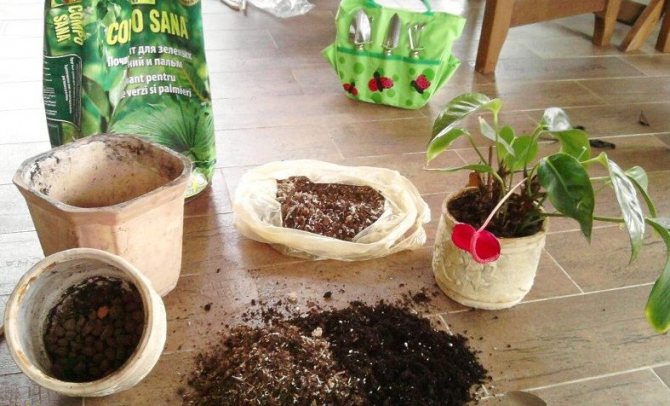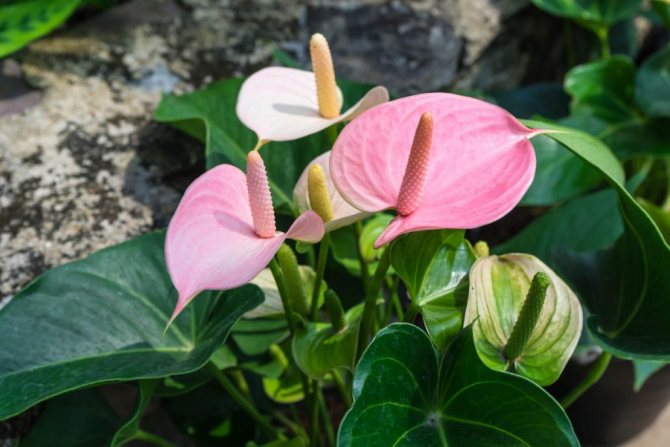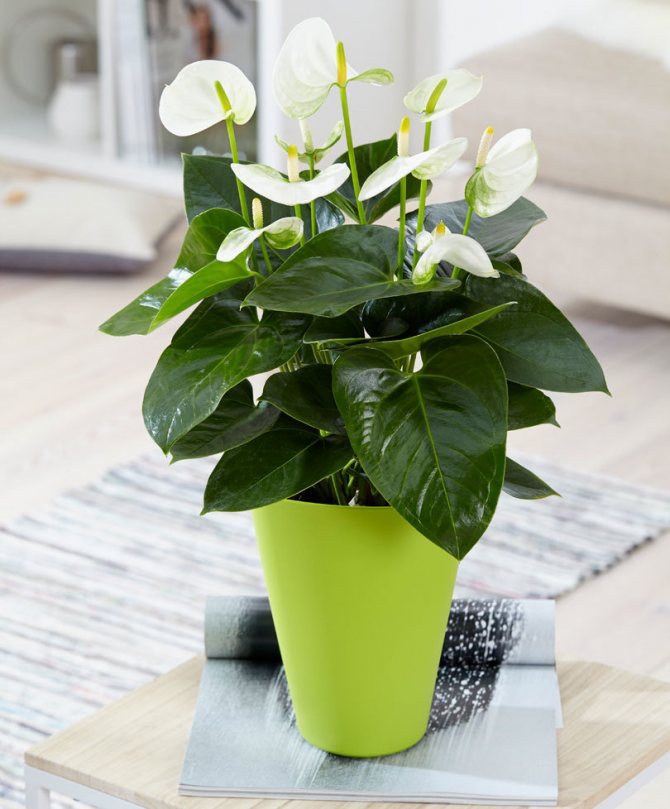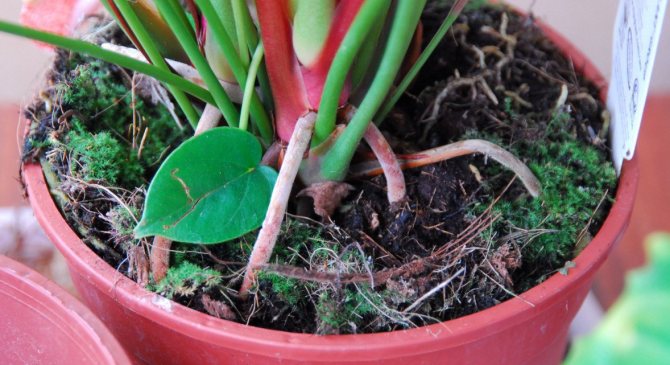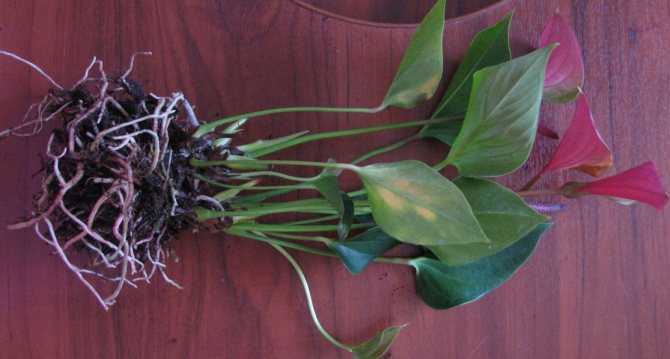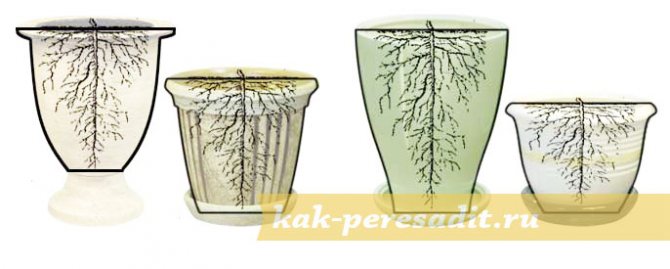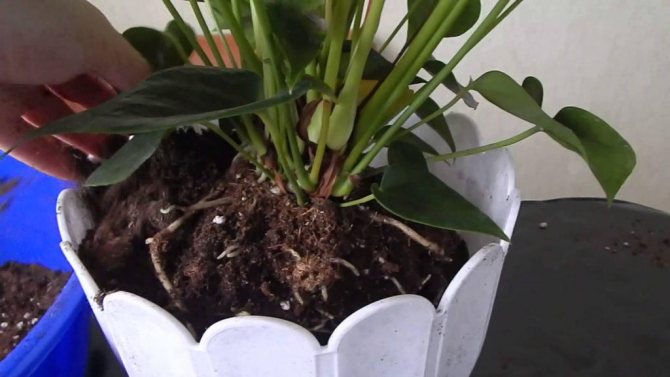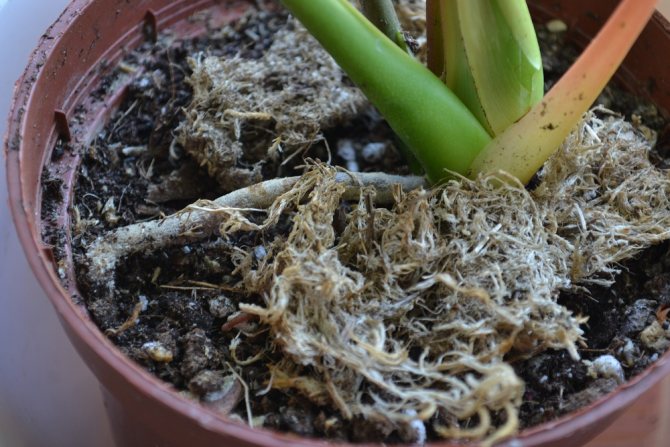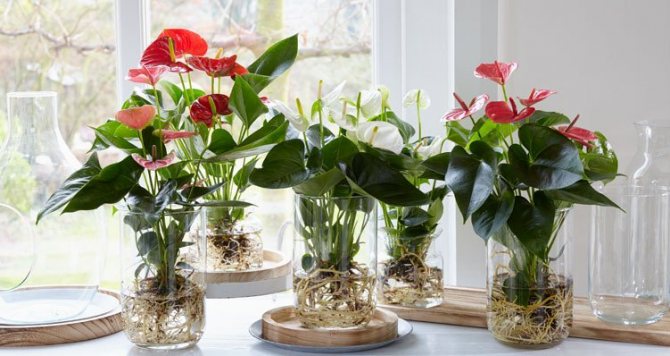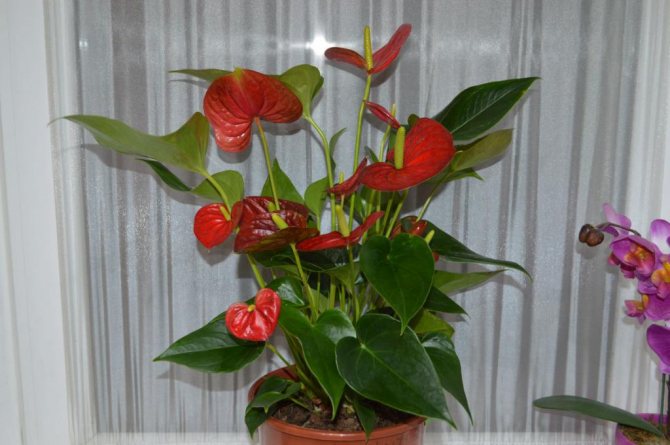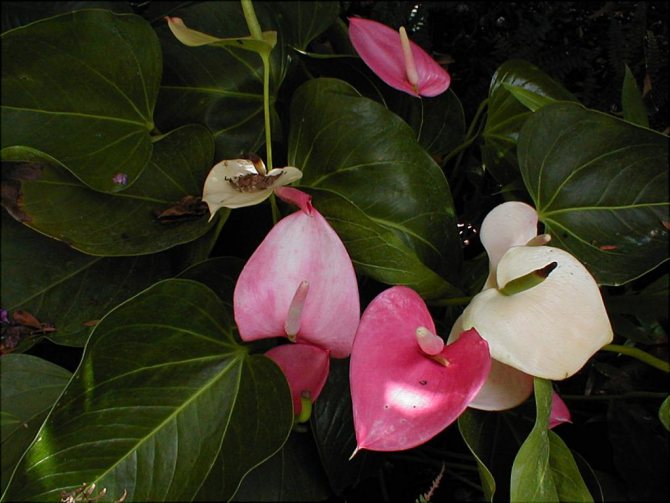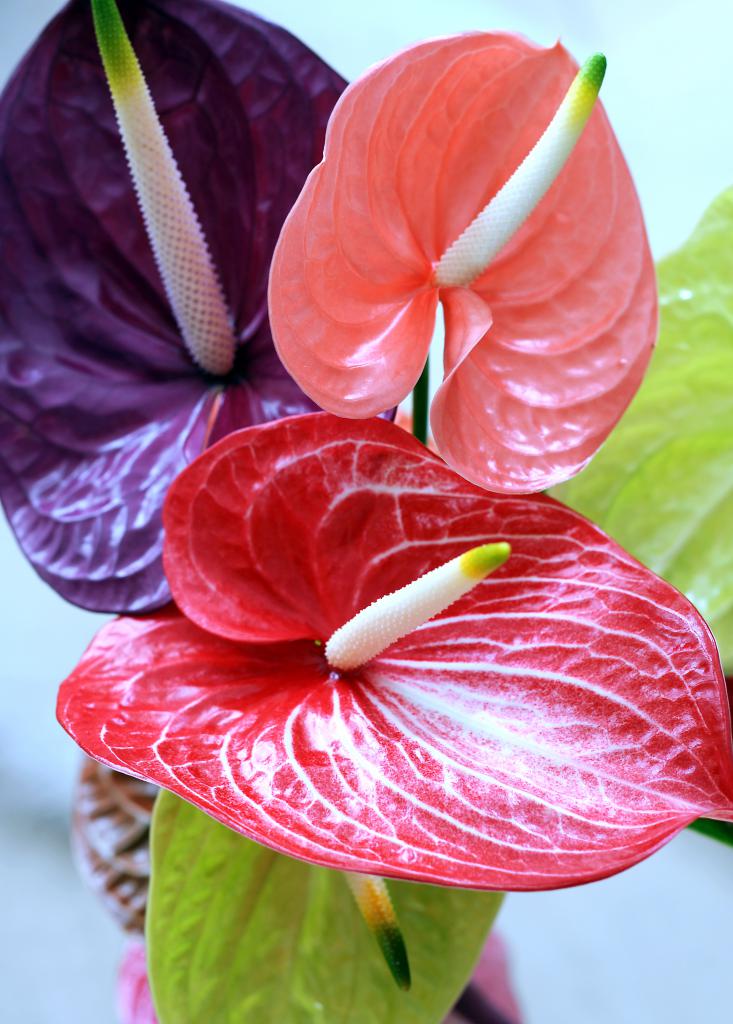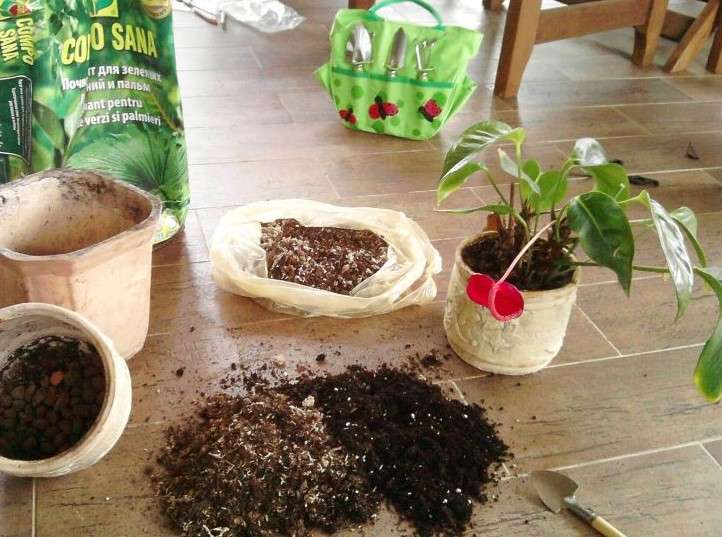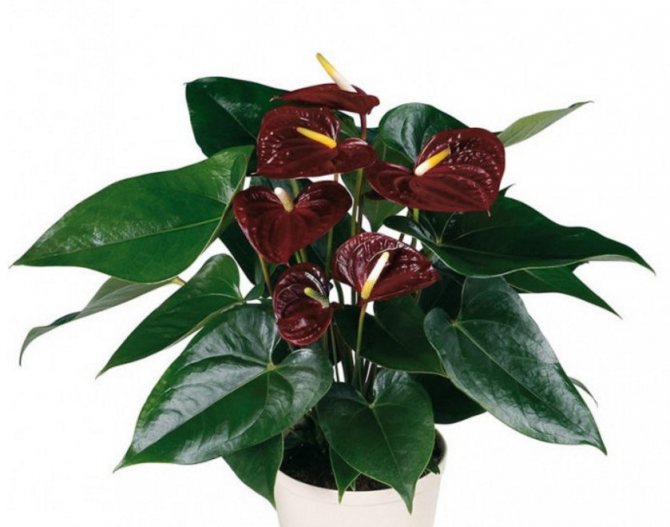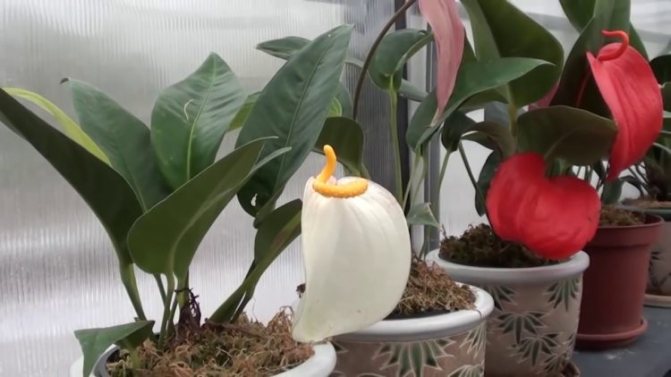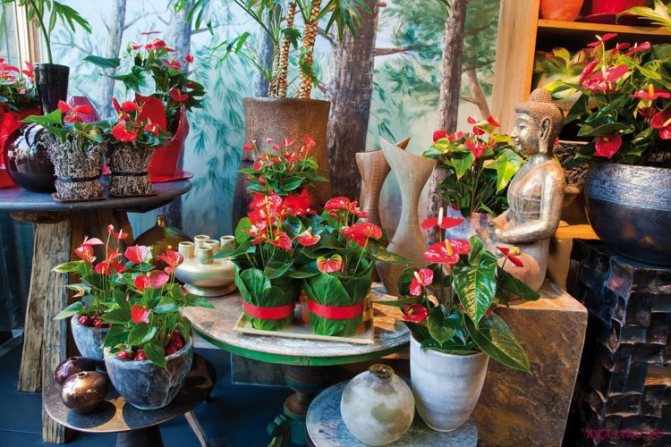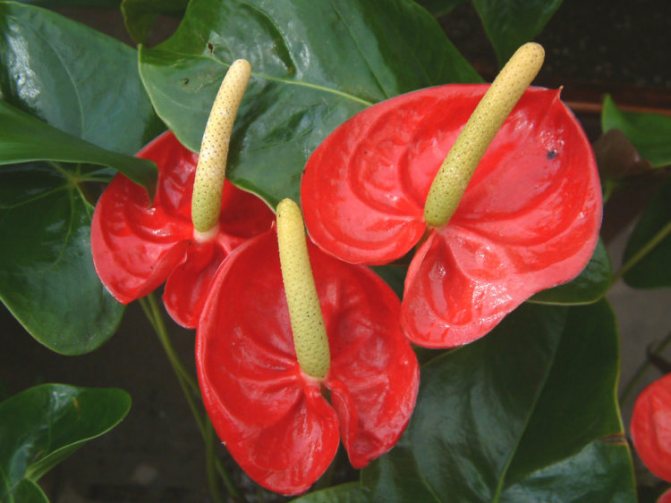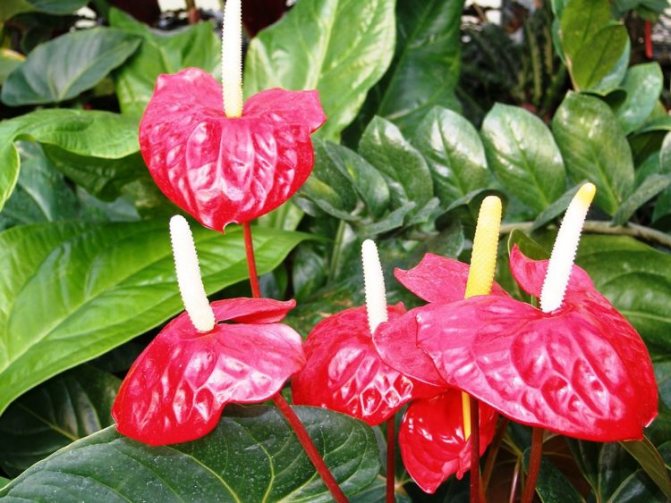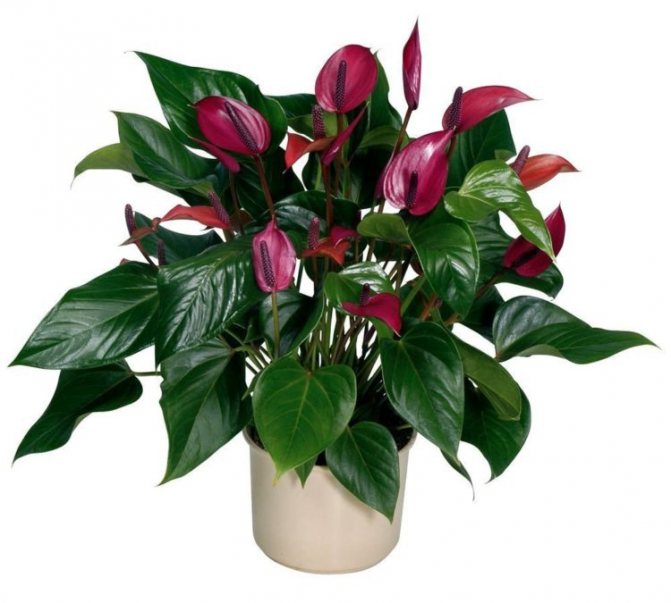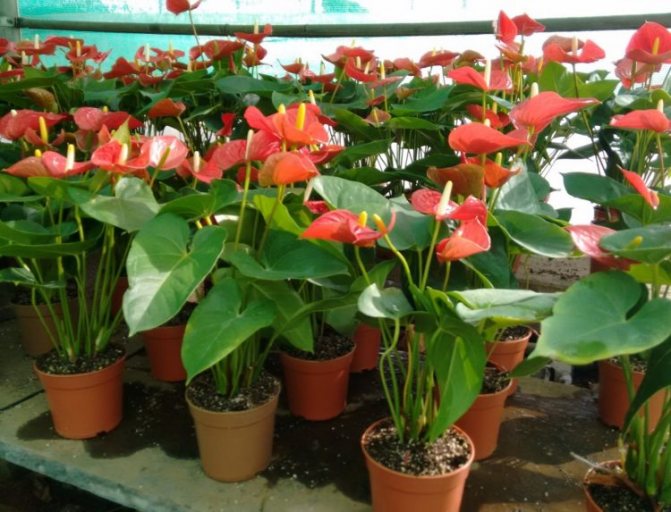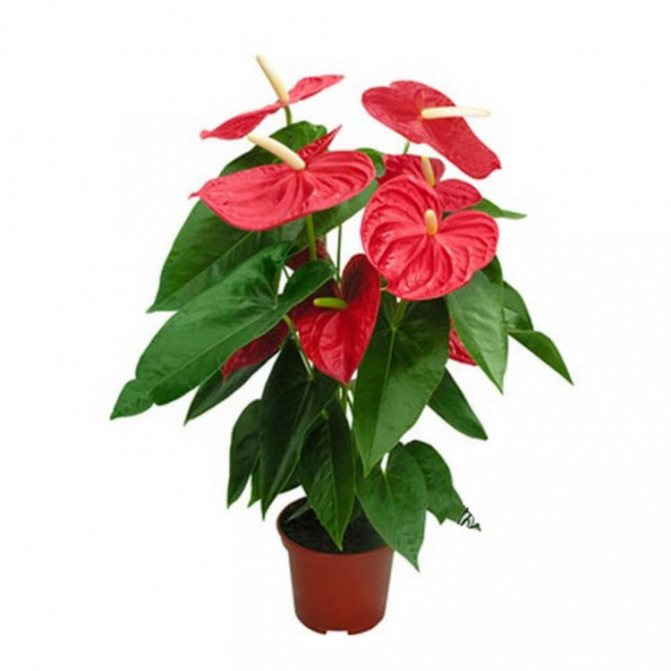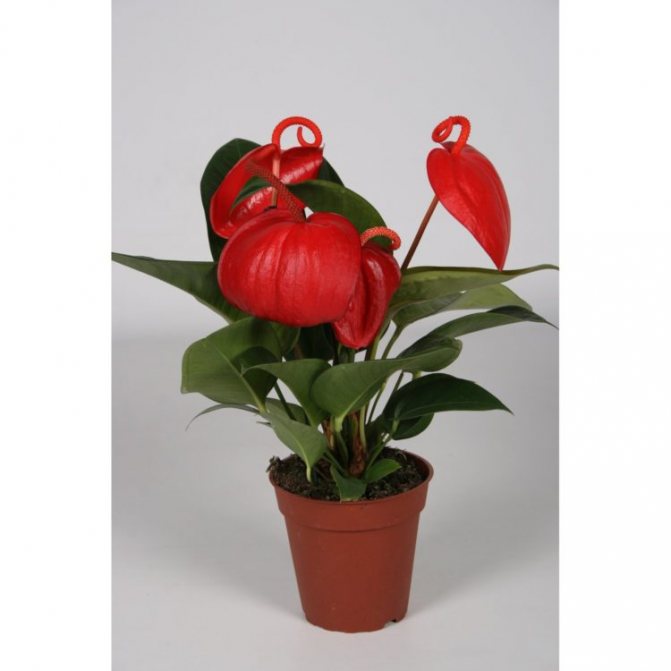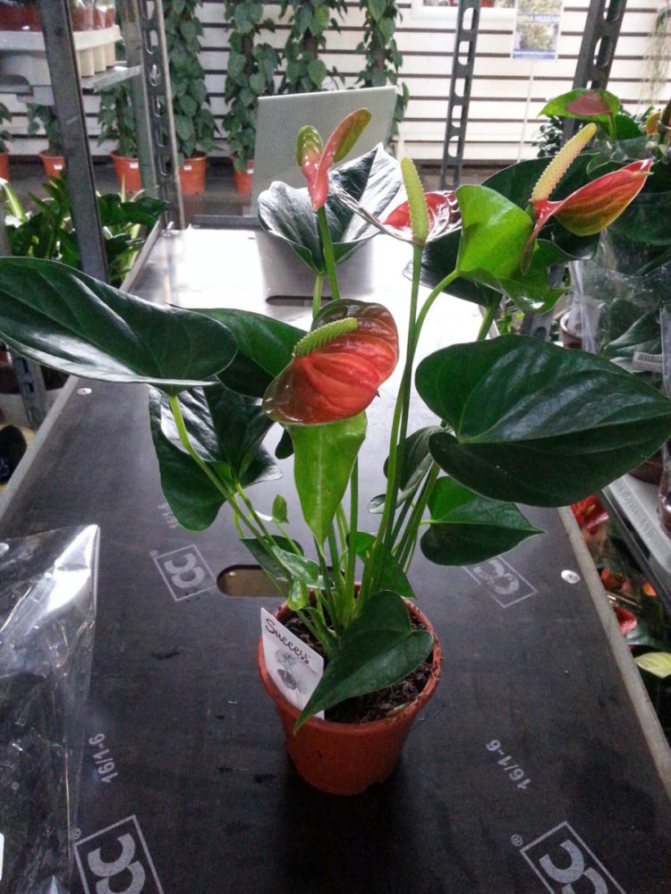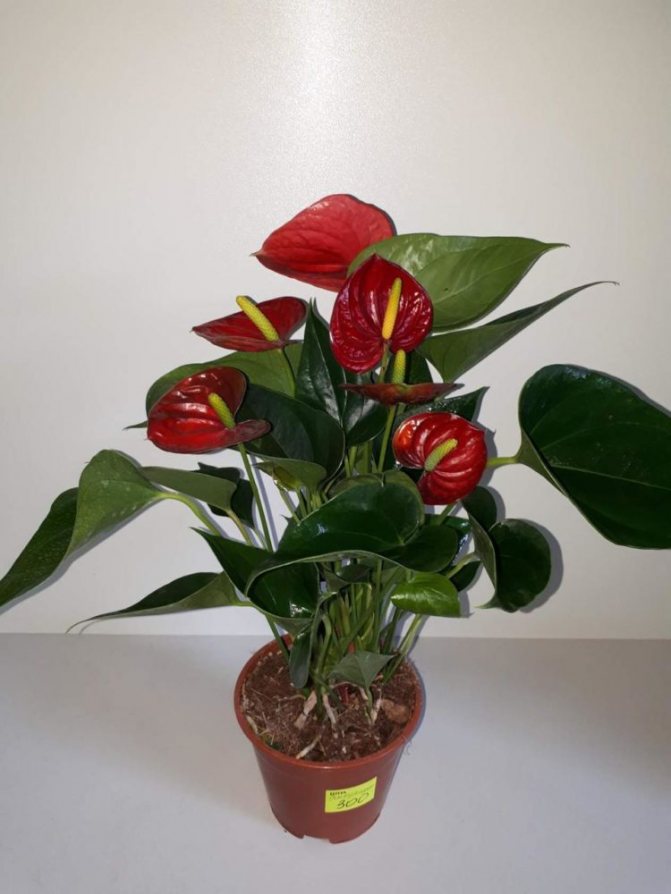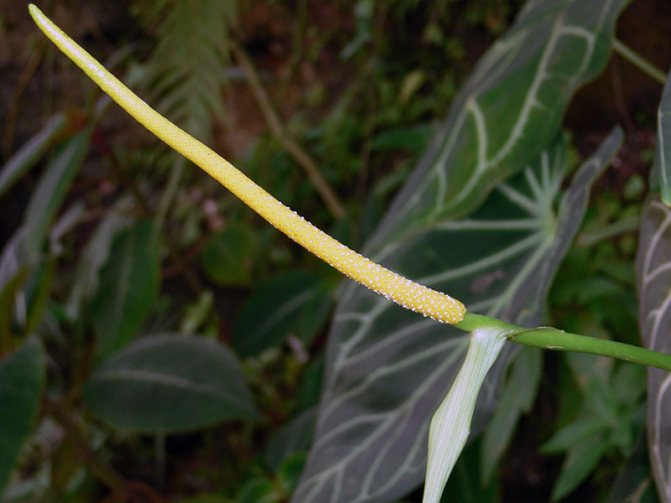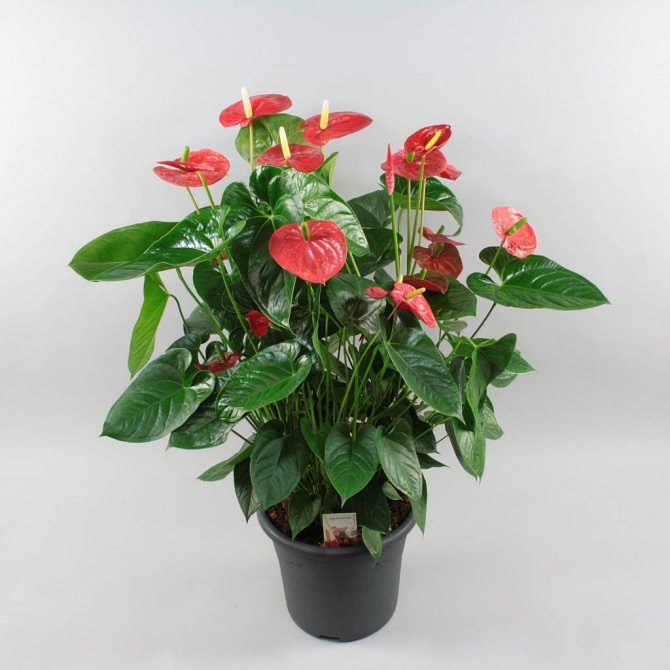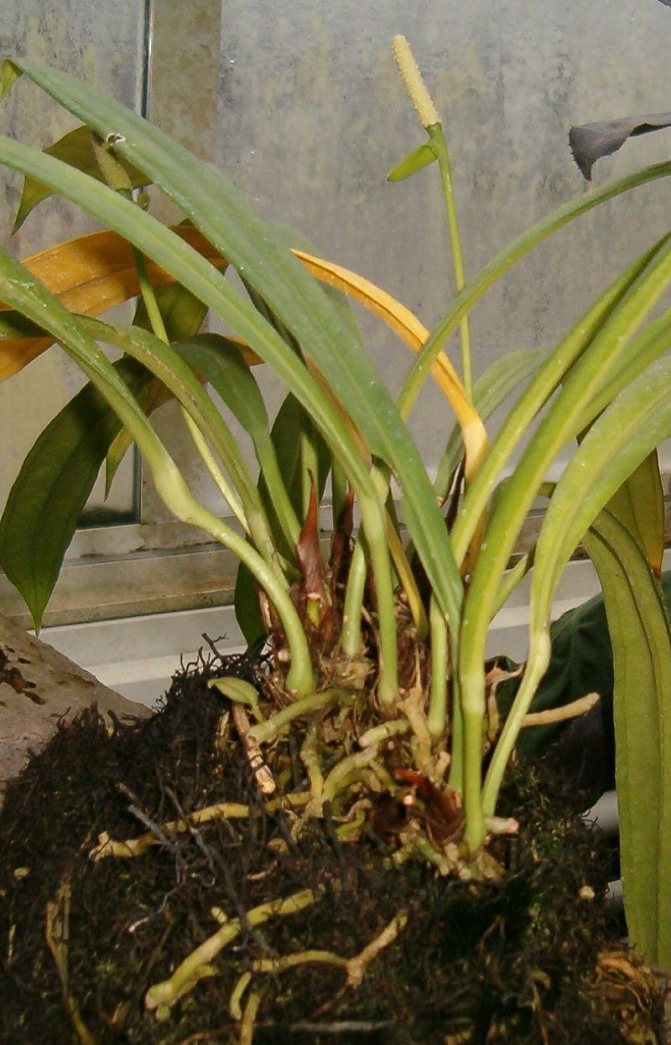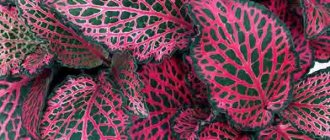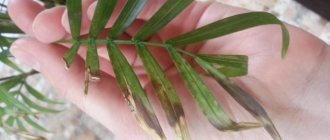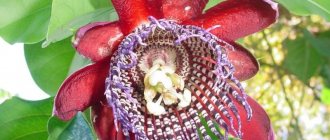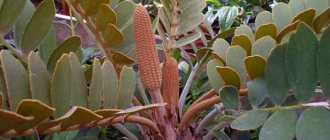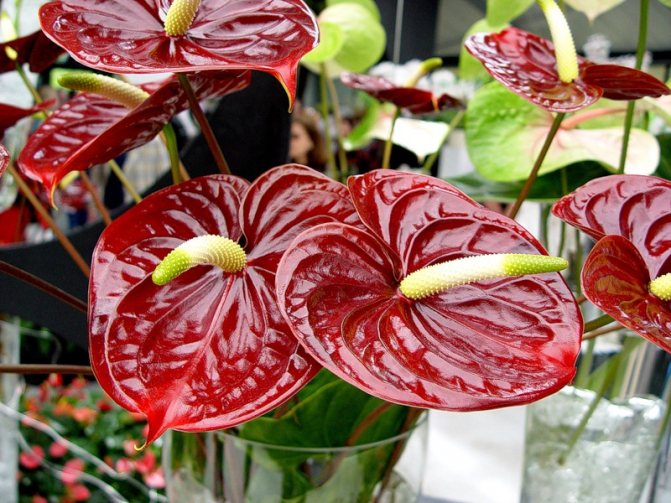
- October 18, 2019
- Flowers
- Natalia Miroshnikova
To grow anthurium, or, as it is also called, the flower "male happiness", is only possible for experienced flower growers, because this plant cannot be called unpretentious. Culture transplantation causes particular difficulties for many. And without certain skills and abilities, it is difficult to understand when and how to hold this event. From our material, you will learn how to transplant anthurium step by step at home, and we will also share the secrets of caring for the plant.
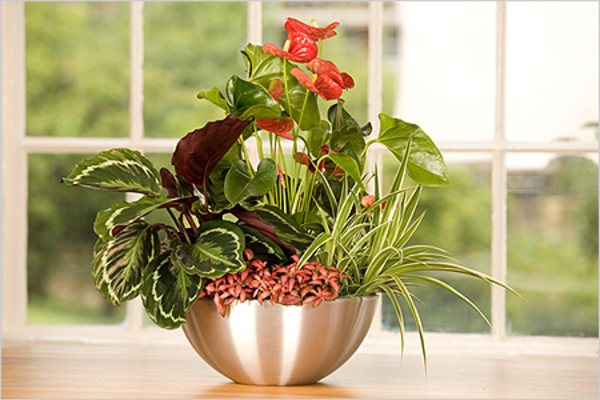

When to transplant a flower
Anthurium transplant may be required for the following reasons:
- The flower was purchased at the store. If you have just bought an anthurium, then you need to transplant it within the first three days. The fact is that in stores, flowers are grown in a special peat mixture that retains moisture for a long time, so the plant needs less care. But this substrate is not suitable for long-term flower cultivation, so it needs to be replaced.
- Planned transplant. Young flowers should be replanted annually until they are five years old.
- The pot has become small. An anthurium transplant should be carried out when the roots of a flower peep out of the drainage hole. In this case, the event should be started as soon as possible. Otherwise, the roots will begin to braid the pot outside, and then the chance of injuring the plant during the procedure increases several times. And if several roots of a flower are damaged during transplantation, this can even lead to the death of the anthurium.
- Soil depletion. The need for transplanting is indicated by the appearance of a white coating on the soil surface.
- Pests. If even with proper care, the anthurium looks painful and lethargic, you need to examine its roots for the presence of insects. And if pests are found, you should immediately transplant the flower into a new pot.
- Diseases. If you take care of the flower incorrectly, the plant can get sick. For example, due to excessive watering, the roots of anthurium can rot. In this case, only an emergency transplant will help to save the flower. Also, the event needs to be urgently held if mold has appeared on the soil. This phenomenon suggests that the plant was either overdried or flooded.
- Landing in the wrong ground. If after transplantation the anthurium does not grow, and its green mass looks deplorable, then this means that you initially picked up the wrong substrate. And it needs to be replaced urgently. In addition, the procedure must be carried out if the anthurium turns yellow after transplantation. Most likely, you used contaminated soil, and now the plant is suffering from bacteria and pests.
When to rejuvenate anthurium
Simple rejuvenation of anthurium is usually carried out together with its transplant. There are several ways - by cutting - to separate the old branches from the overgrown main bush. In this case, they should be separated together with the roots and cutting off the upper part.
There is one more "cutting" method, which is more popular among experienced growers. The top is cut off along with the roots (or several tops), and the trunk remains in place.After this simple procedure, you need to reduce the regularity of watering due to the fact that all the leaves have been harvested, and the flower does not yet have the ability to give moisture outside. Soon, young leaves will appear on the stem, which are then separated for the purpose of a new reproduction of the plant.
It is recommended to use such options during transplantation for flower growers who have not yet gained enough experience. In any case, it will be possible to save a beautiful flower for a while. Over time, you can move on to more "radical" methods of rejuvenation, which will require much more time and practical skills.
When is it recommended to transplant a flower
The anthurium transplant, which we will consider later, is best done in early spring, before the onset of the heat. Then the plant tolerates stress from the procedure more easily. Of course, if necessary, you can transplant the flower at other times of the year. But it is advisable not to hold this event at temperatures above +30 degrees. In such a heat, the roots of the flower cease to absorb moisture normally, which worsens the survival rate of the culture.
Can Anthurium be transplanted during flowering? It is advisable to postpone this event until the onset of a dormant period. But if the flower is sick, and it needs an emergency transplant, then immediately proceed with it. But before changing the soil and pot, still cut off all the flower stalks. So the plant will spend energy on acclimatization, and not on supporting the buds.
Is it allowed to transplant a flowering plant?
If you start asking flower growers how to transplant anthurium correctly, before most of them will tell you that it is best to do this after the flowering period is over. However, this crop does not respond as strongly to transplanting during flowering as other ornamental plants. Therefore, as a last resort, the procedure can be carried out. However, before that, it is recommended to cut off all wilted leaves and cut the peduncles so that the flower will quickly take root in a new place. If you do not want to lose the decorative qualities of the anthurium, then the earthen lump should be handled with great care so as not to damage the root system.
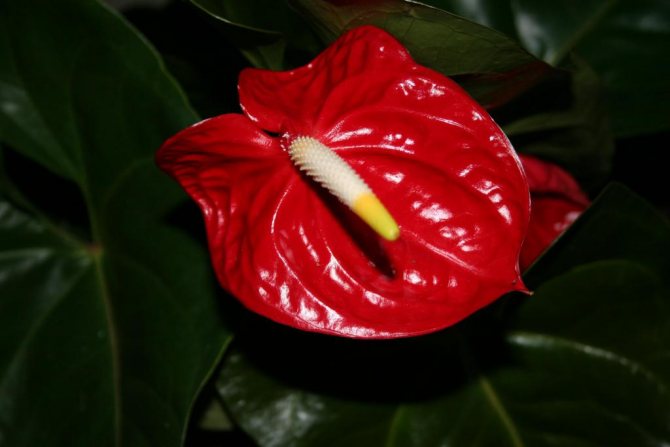

Pot
What do you need to transplant anthurium? The first step is to prepare a suitable pot. Prefer containers with a depth greater than width. As for the material, it is better to choose plastic or glass vases for a flower. As a last resort, a clay pot is also suitable, but only with a glazed inner surface. Otherwise, the roots of anthurium will grow into the walls of the flowerpot, and you easily injure them during the procedure.
To choose the right pot size, follow these guidelines:
- For a planned transplant, choose a flowerpot whose diameter is 2-3 cm larger than that of the previous one.
- If you want to get new shoots of a flower in order to use them for reproduction in the future, transplant the anthurium into a wider container. This will give an impetus to the development of young growth. But keep in mind that in this case, the plant will bloom only after its roots are completely entwined with an earthen ball. And it will take a lot of time.
- If you want to achieve beautiful flowering, then give preference to flowerpots with a diameter larger than the previous one by no more than 2 cm.
- If during the transplant you also carry out the reproduction of the flower, then for the children choose small pots with a volume of 200 g. The mother plant can be transplanted into an old flowerpot, or into an even smaller one if its root system has noticeably decreased.
Having decided on the container, do not forget to disinfect it before transplanting. To do this, thoroughly wash the pot with laundry soap, and then pour boiling water over it. It is especially important to carry out this procedure for pots in which plants were previously grown.
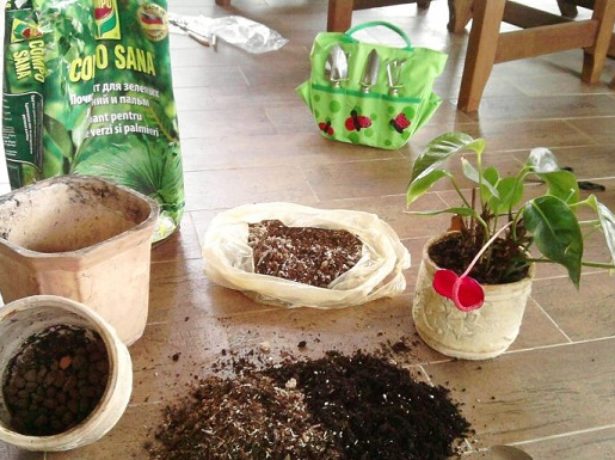

Why might such a need arise?
Sometimes a plant is in dire need of a transplant precisely during active flowering.There may be several reasons for this:
- the old flowerpot has become cramped for a flower, and the roots have braided the whole earthy ball;
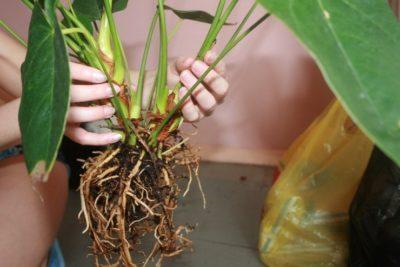

the soil was selected incorrectly, which affected the development of anthurium;- rot appeared on the roots of the plant;
- the root system is sick.
Over time, the soil in which the anthurium is planted is depleted. A sign of this is the appearance of brown or whitish spots on the topsoil. If the plant is not urgently transplanted into new soil, it may die.
Healthy Adults plants every two to three years also need to be transferred to a larger poteven if they show no signs of disease.
Priming
Flower "man's happiness" prefers loose, fertile soil with a slightly acidic reaction. And for this plant, a mixture designed for orchids is suitable. If you want to create land for transplanting anthurium yourself, then mix the following components in equal parts:
- sheet soil;
- peat;
- coniferous soil;
- coarse sand.
Move all components carefully and remove large parts. After that, disinfect the substrate by placing it in the freezer for a day. A little charcoal and pine chips can be added to the finished soil.
Step-by-step instruction
So we got to the question of how to carry out an anthurium transplant at home. If you have been breeding indoor plants relatively recently, then our instructions will help you cope with this task.
- We prepare everything necessary for plant transplantation: a flowerpot, soil, drainage, a disinfected knife, settled water and a root growth stimulator. The height of the container must correspond to its diameter.
- We shed the plant well, after which we hold the anthurium by the stems at the surface and take out the plant along with the earthen lump.
- We carefully examine the roots and remove all damaged and rotten parts, after which we treat them with crushed coal and fungicides.
- We put a drainage layer on the bottom, consisting of bark, pebbles or expanded clay, after which we pour a little soil on top. We install the plant in a flowerpot and add the required amount of soil so that all the roots are covered with earth.
After that, all that remains is to choose a warm place without drafts and bright sunny colors, so that the plant is in complete rest for several days.
First transfer after purchase
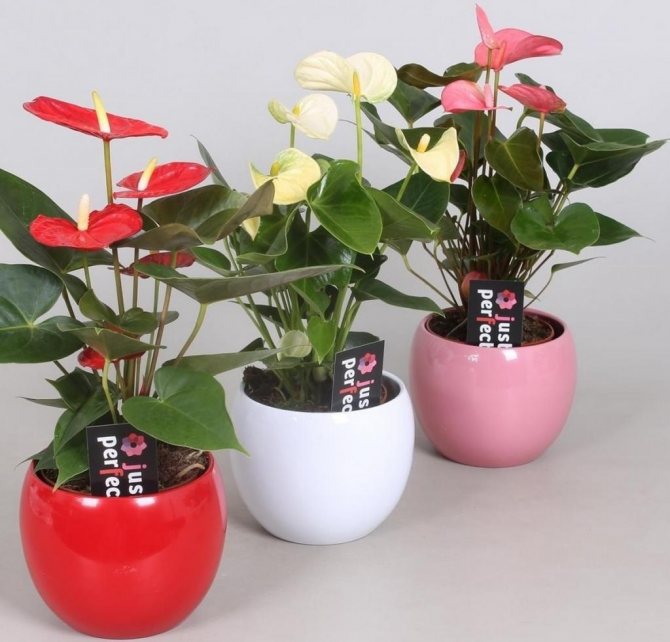

The transplant of the purchased anthurium must be carried out in the first three days. Why such urgency? The fact is that the sooner you hold this event, the faster the plant will acclimate to the conditions of your apartment. Please note that this flower is poisonous, so be sure to wear gloves during any manipulation of the plant.
So, how to transplant anthurium at home step by step:
- Remove all peduncles, if present.
- Remove the plant carefully from the pot.
- Using a wooden stick, carefully remove all the peat soil in which the flower was grown in the store.
- Treat the roots with any fungicide, such as Fitosporin or Fitolavin.
- Pour drainage from broken brick, pebbles or expanded clay onto the bottom of the new container. Please note that this layer should occupy a quarter of the flowerpot volume. Cover the drain with sphagnum moss.
- Place the plant in the center of the flowerpot and gently straighten the roots. Fill the voids with substrate so that the growing point is flush with the ground.
According to the same principle, anthurium transplantation is carried out when roots rot. If the room is warm, you can moisturize the flower right after the event. If the room is cool, then the first watering should be done 1-2 days after the procedure. By this time, the injured roots will heal and will not rot when moisture gets on them.
How to rejuvenate anthurium
Old anthurium, as a rule, has a branched and overgrown system of air roots, which are clearly visible under the leaves and on the trunk. The main method of renewing a plant of an old flower is to cut its upper part together with the leaves so that two or three roots remain, after which the shoot can be safely planted in a new place. In order to more reliably root the apex, breeders use one of three popular methods:
- first, the roots grow and only then the top is cut off. To achieve the growth of the top, the stem is exposed and should be wrapped in moss. The moss should be kept slightly damp at all times, waiting for the roots to begin to sprout through it. After the roots sprout, the stalk is finally cut off and planted in a previously prepared container - along with a moss lump;
- loose soil is prepared: its main composition is a mixture for aroid plants with the addition of coal, coconut fibers, vermiculite and crushed bark of pine trees. The top of the flower is cut off and planted in a new pot. In this case, the roots should be immersed in the soil, but without deepening the rosette. Rooting is fast. The correct irrigation technique is important: so that there is a possibility of a free outflow of water from the container, it is necessary to purchase pots with drainage holes at the bottom;
- the third method is the simplest possible: the cut off top is simply placed in a glass of clean water, while the trunk should be submerged only partially in the water, and the leaves are on top. When the roots sprout, the shoot is ready for planting. The only negative in this case is the possibility of decay, especially if the room is too cold.
For optimal rooting, young shoots planted in the ground should be refreshed with warm sprays with plain water, and immediately before planting, placed in a root growth stimulator. It is recommended to transplant anthuriums in a warm room, at a temperature of twenty to twenty-five degrees, and if all activities are carried out correctly, you can get several healthy rooted shoots, which in the future will certainly delight you with their exotic beauty.
Rejuvenation and reproduction of anthurium:
We will tell you how to properly transplant an anthurium flower "male happiness" at home. We consider different situations: soil renewal, after purchase in the store, as well as during flowering.
We describe which pot is better to choose, and what kind of land is needed for transplanting, as well as caring for a flower after it and possible problems.
Planned transplant
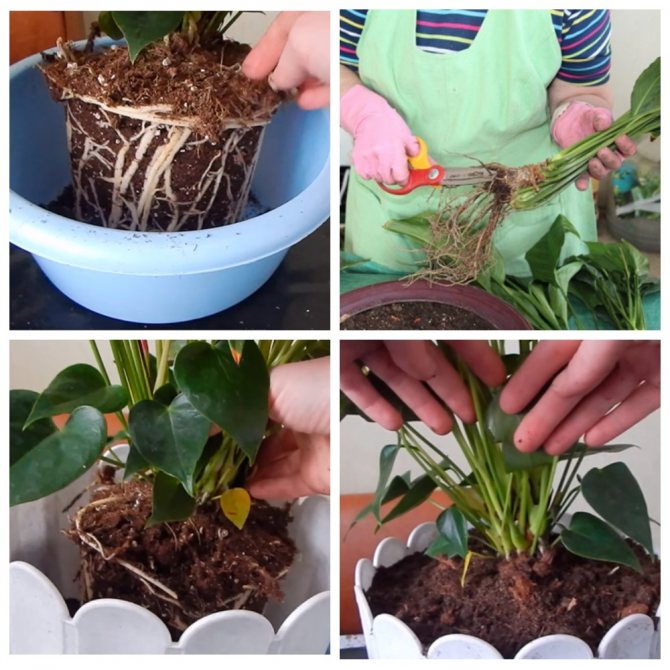

Conduct the event as follows:
- The day before the event, moisten the soil well using the bottom irrigation method. To do this, place the flower pot in a container filled with water for half an hour.
- Carefully remove the plant from the old flowerpot. Using a wooden stick, carefully remove the earthy ball, taking care not to damage the roots of the anthurium.
- Examine the root system of the flower. If pests are found, then treat the shoots with an insecticide, for example, "Aktellik". And also remove any rotten and damaged roots. Do not forget to treat the cuts with crushed charcoal.
- Remove all buds and damaged leaves.
- Place a layer of drainage ¼ of the volume on the bottom of the new pot. For these purposes, use brick chips, expanded clay, or pebbles. Cover the drain with sphagnum moss.
- Place the plant in the center of a new flowerpot and gently straighten the roots. Fill the voids with soil, and cover the anthurium with sphagnum moss on top.
Follow-up care
In order for the transplanted plant to quickly take root and acclimatize, it is necessary:
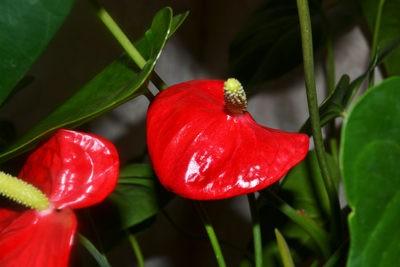

provide the transplanted anthurium with an ambient temperature of 18 to 28 degrees Celsius;- at first, tie up the plant if it needs support;
- protect the flower from direct sunlight, as well as from drafts;
- do not water the transplanted plant for three to four days until the topsoil dries out;
- for three to four weeks, do not feed the anthurium with any fertilizers;
- spray the leaves regularly with a spray bottle.
Transplant and reproduction
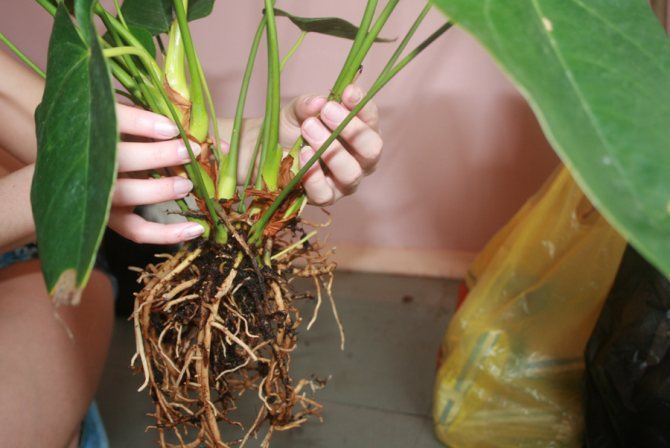

Anthurium can be easily propagated during transplantation. To do this, after you take out the flower from the pot, carefully separate the children from the mother bush. Each of these sections should have several leaves and a strong root system. Place the children in individual pots using the same algorithm as for transplanting adult plants.
Getting to know the plant
First of all, let's introduce you to the hero of the story. Anthurium is one of the representatives of the aroids. In nature, it can be found in the tropics of South and Central America. In total, about 500 species of anthuriums are known.
Florists appreciate them for a kind of flower that resembles a fabulous sail. Someone also prefers purely deciduous species. However, what we think of as a sail flower is not a petal! It is just a brightly pigmented bedspread. But the flower itself is a small and rather ordinary-looking ear, which is protected by the "sail". As soon as it fades, the bright "petal" loses its amazing color, turning into an ordinary green leaf. I must say that anthurium flowers smell wonderful - each species has its own unique aroma.
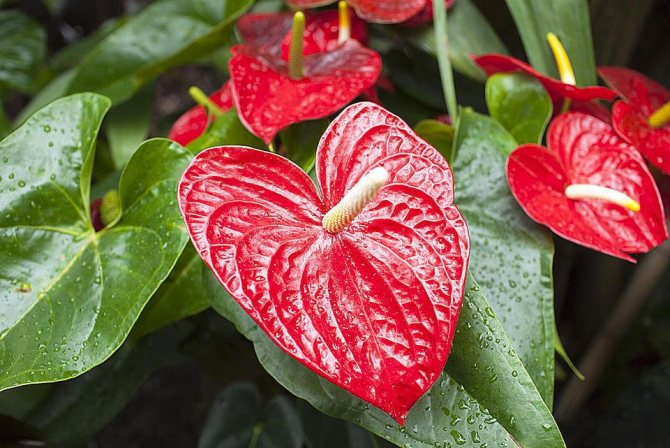

The plant can reach a height of 70 cm. It has large, hard green leaves, covered with a matte thin film. Their shape can vary from cordate to sagittal. We must also remember that all parts of the plant are poisonous! Therefore, install it out of the reach of small children and pets.
Humidity
It is important for the transplanted anthurium to create conditions with high humidity. To do this, install a special device next to the pot - a humidifier. If you do not have such a device, then put the flower in the aquarium. If this is not possible, then at least keep containers of water next to the plant. Better yet, place the pot on a pallet with damp expanded clay or moss, but make sure that moisture does not reach the drainage hole. Otherwise, the flower will suffocate.
Also, remember to spray the foliage of the crop daily. For this, use warm and filtered water, and during the procedure, make sure that moisture does not get on the anthurium buds.
How to properly transplant anthurium at home? Step by step and video
Transplant "male happiness" with healthy roots only by the transshipment method (without washing and replacing the soil!), Because they do not like to be disturbed, and they are also very fragile and can be easily damaged in the process of soil removal.
It is necessary to free the root system from the ground only in problematic anthuriums or if it grew in an improperly selected soil mixture.
- Place newspaper, tape on a table, or place a bucket, large pot, or basin. Drain the bottom of the pot, and put a small layer of prepared soil on top of it and moisten it a little to seal.
- Gently grasp the base of the stems with one hand, and with the other hand hold the bottom of the container, and gradually get the "man's happiness" out of the pot. If you cannot get it, then pour it a little or near the very edge of the pot, carefully pierce it in 3-4 places with a thin stick, knitting needle or fork.
- If the topsoil is loose, you can remove it very carefully. Place the anthurium in the center of the container so that the aerial roots are slightly lower than they were in the old pot. About 3-4 cm below the top of the pot.
- Top up the soil at the bottom and gradually fill it near the sides of the pot. The root collar must be hidden under a 1-2 cm layer of earth, otherwise "male happiness" is in danger of death.At the same time, about 2 cm should also remain to the upper edge of the pot - a place for sphagnum. Tighten the substrate periodically so that there are no air cushions (tap the pot and rub it lightly).
- Water the anthurium moderately so that the potting mix is soaked in moisture and enveloped in the roots. If possible, spray anthurium with growth stimulants "Zircon" (4 drops per liter), "Epin Extra" (8 drops per liter of water) or others. This will help the flower to transfer more easily.
- Place the flower in a place out of direct sunlight or shade it for 5-7 days.
Rules and Tips
- A prerequisite for a successful transplant is the correct planting depth - the roots should be covered with a layer of soil mixture or at least covered with sphagnum. Therefore, with each transplant, "male happiness" must be planted, a little deeper. The root system is very sensitive and, upon contact with air instead of earth, can dry out, leading to the death of the plant.
- Anthurium is a very fragile plant, touch the roots and stems carefully. Always use gloves, as it contains substances that irritate the skin.
- If you are replanting a weak or sick specimen, then at the end it is better to make a "greenhouse". Cover the flower with foil or a transparent bag, air it daily. High humidity makes it possible to reanimate a plant that has lost even more than half of its leaves in 5-7 weeks.
- Remember to have sufficient drainage thickness and plant in suitable soil.
How to moisturize a plant
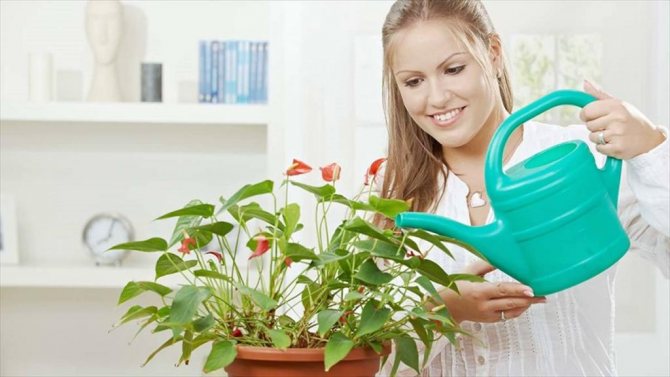

For the first two weeks after transplanting, water the flower regularly, but in moderation. If you performed the procedure in the summer, then moisten the soil with a little water every 4 days. In winter, watering the plant once a week is enough. And use for irrigation only settled and filtered water, the temperature of which is 2-3 degrees higher than room temperature. Also remember to drain excess liquid from the sump 20 minutes after watering. Otherwise, the roots of the plant will rot.
After two weeks of gentle watering, return to the normal irrigation regime, that is, moisten the flower when the substrate is 1/3 of the volume dry.
Features of growing crops
Despite the high indicator of decorativeness, it is quite easy to care for the anthurium at home. Anthurium transplantation is also a rather important part of care, but we will talk about it a little later.
Like most tropical plants, "male happiness" prefers to be in humid air, but does not tolerate cold drafts and direct sunlight. In view of these features, it would be best to place a flowerpot with a flower on the windowsill of a window that faces the eastern or western part of the building. You should also take care of additional shading in the summer.
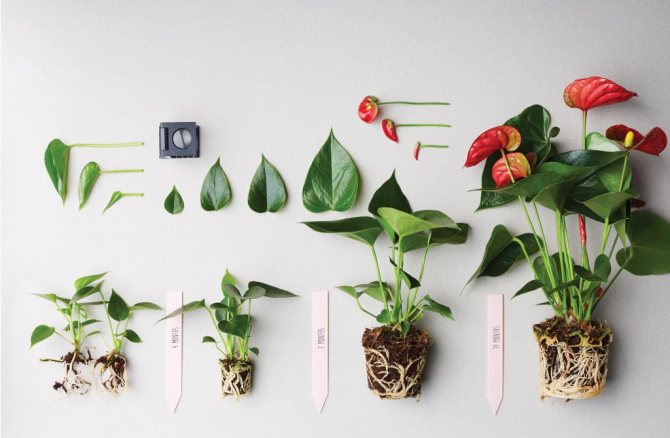

Watering should be moderate, but frequent enough. In summer, the crop is watered 3 to 4 times a week, and in winter one will be enough. It is recommended to regularly pour out the water accumulated in the pan so that the earthen lump does not become waterlogged, otherwise it can provoke the development of various fungal diseases.
The soil is fertilized one to two times a month. However, the feeding procedure is carried out only for flowering plants. For this, it is recommended to use complex mineral and organic fertilizers, which will not be difficult to purchase in any specialized store.
What else does proper home care include? Anthurium transplantation should be carried out at regular intervals, otherwise the plant will begin to ache due to lack of space for the development of the root system. We will talk in more detail about all the features of this process in the following sections.
Pests and diseases
Anthracnose
This is the most devastating disease. It manifests itself as the beginning of decay or in the form of dark spots on the plant. It occurs due to unregulated soil moisture. The damaged areas must be removed.The plant should be treated with a 1% solution of Bordeaux liquid.
Root rot
Root rot caused by pityium spores often causes serious damage to the plant. The flower withers, turns yellow, is easily pulled out of the soil. This disease can be controlled by applying a pesticide to the soil - quintozene.
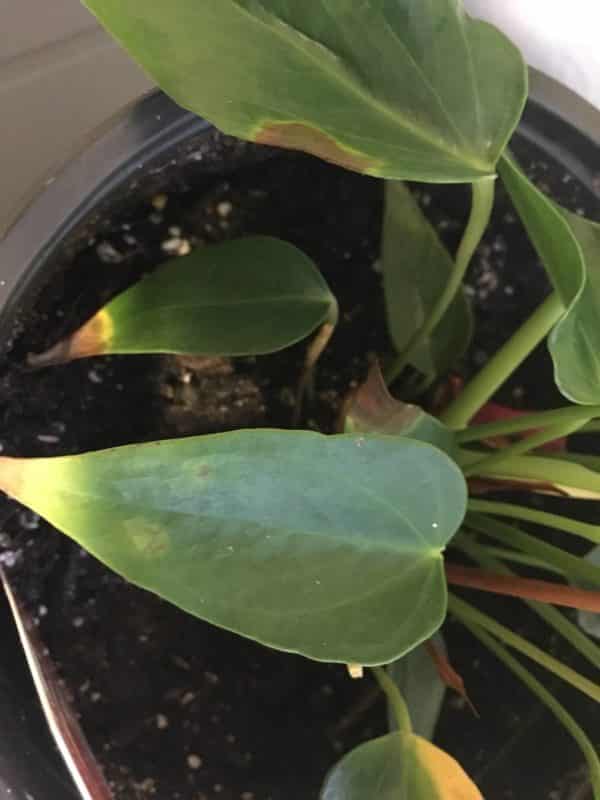

Anthurium disease - the appearance of yellow spots on the edges of the leaves.
Spotting
Spots on the leaves are caused by the septoria fungus. It appears in the form of white, often merging dots. It is controlled by spraying 50 grams of the active ingredient of the pesticide zineba in 15 liters of water. It is repeated at intervals of 2-3 weeks.
Powdery mildew
Disease caused by the fungus Erysiphe COMMUNIS. A white coating appears on the leaves, similar to flour. The disease can be treated with a 0.1% organic pesticide solution.
Aphid
Insects suck out the juice, which leads to yellowing and deformation of the leaves, as well as the cessation of growth. Systemic insecticides containing dimethoate and malathion (0.2%) effectively kill aphid colonies.
Shield
The scabbard grows on stems and leaves, sucks out sap and weakens the plant. You can get rid of it by wiping the stems and leaves with a cotton swab dipped in insecticide or by spraying 0.2% malathion.
Spider mite
Small mites cause yellowish mottling of the leaves, which later turn brown and dry out. It is necessary to spray the affected plant with a 0.2% malathion solution (8 ml in 10 liters of water).
Thrips
Thrips suck vital sap from the leaves, causing a mottled effect on the stems and inflorescences. You can fight using the same methods as in case of damage to anthurium by aphids and a scabbard.
Propagation of anthurium by cuttings
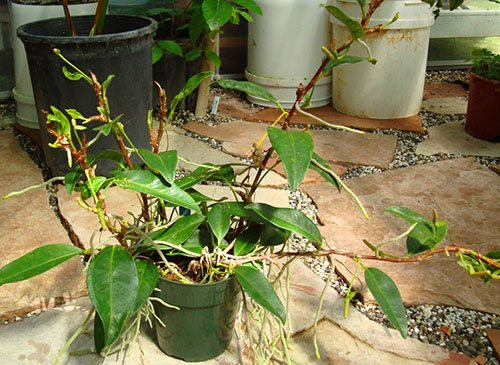

Many types of anthurium can be propagated by cutting off a shoot with aerial roots and several internodes with a sharp knife. Divided into sections with one or two nodes and a pair of leaves, the stem is rooted in moist perlite. The planting depth should not exceed 5 cm, and the growth point of the future plant must be left above the soil. Anthurium cuttings sprinkled with substrate are covered with a film and placed in a warm place, where they will have to spend 15–20 days.
Photo of flowers after resuscitation
Varieties for the windowsill
Although a huge number of anthurium varieties are found in nature, mainly four hybrid varieties are grown on window sills. More in greenhouses. It's just that not all tropical guests can adapt to the conditions of city apartments. But even those who can are very capricious.
- Andre. A plant with a short stem, leathery, heart-shaped leaves. This species conquered flower growers with fancy inflorescence shades, an expressive bracts and a year-round flowering period. Another feature of the variety: the bedspread does not fade after flowering, but coarsens, acquires a green color. But there are also disadvantages: reviews say that "Andre" is capricious, so it is difficult for novice growers to provide him with proper care and achieve flowering all year round.
- "Scherzer". The least capricious kind of "male happiness". The plant is easier than other varieties to adapt to living conditions. You can recognize it by the shortened stem, on which dark green elongated leaves flaunt. A distinctive feature is the roundness of the bedspread. The oval bracts can be almost any color: white, pinkish, burning red, yellow, and even speckled.
- "Crystal". This variety is grown to admire the leaves, because it blooms inconspicuously. But the leaves are really beautiful: large, heart-shaped, velvety, with bright silvery veins. The color of the deciduous canvas changes: you brought home a flower with a bronze-purple veil, and, a year later, you received a dark green one.
- "Majestic". Like Khrustalny, it belongs to decorative deciduous trees.The flower grows quickly, its leaves can reach impressive sizes - about 40 cm. The leaf is green (sometimes purple) with distinct white veins. Growing this variety is difficult. The headache of florists is a tick-borne infestation. This type of "male happiness" is liked by insects more than other varieties.
Breeders are bringing out more and more varieties of the popular indoor plant. From the latest achievements of selection - Anthurium "Andre" with green and black bracts. Looks awesome!
Houseplants Directory
Anthurium transplant: proper care. Learn to water the anthurium after transplanting. Learn how to care for a flower in your home.
Watering anthurium after transplant
Anthurium - luxurious pleasure. A flower will require an investment of energy, but the regal appearance of a red flower on a thin stem will delight a weary grower. The secret to long-term cultivation is renewal.
Why transplant anthurium:
- Free the roots from the shop floor.
- Stimulate post-flowering development.
- Treat the roots if they are sick.
- Renew the old-timer in the house.
Transplantation and reproduction of anthurium lived and described. Follow the link, and then come back if you are just preparing for the procedure. Post-transplant care will be based on rejuvenating and stimulating procedures. The plant will be fed with water and fertilizers.
When to water anthurium after transplanting: after 1.5-2 days, if the top layer of the earth is dry.
How to water: moderately, regularly.
Than: with settled water.
Anthurium dies from waterlogging. Roots do not process more water than their size. Focus on the size of the pot. I still remember the proportions of the root ball, which I managed to see after transplantation.
In the "Bible of indoor plants" there is a recommendation for watering anthurium 1 time in 2 days. The management advises not to leave plants without water. The top layer of the earth is moist and does not dry out completely. After transplanting, watering the anthurium is nevertheless reduced, since the roots received microtrauma. When watering, they will not be able to process the amount of moisture with which we feed, and will rot.
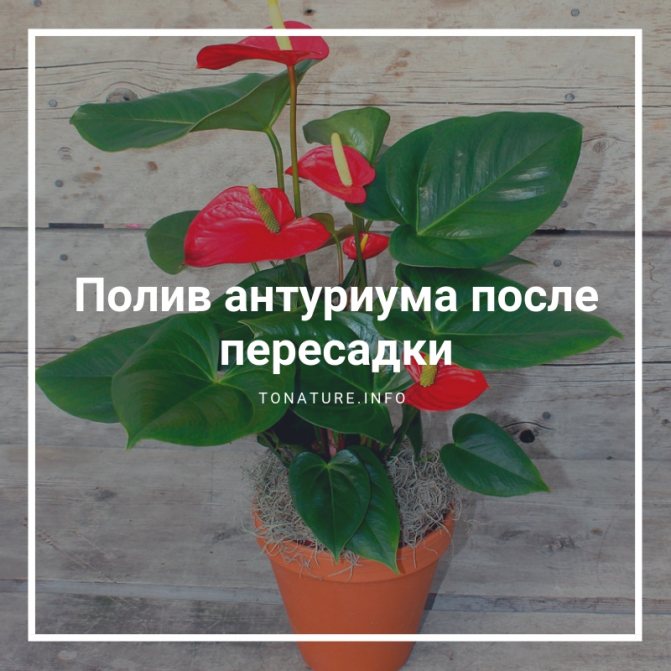

What to add to water for irrigation: 1 teaspoon citric acid.
Let us acidify one and a half liters of settled water for irrigation of anthurium after transplantation. The plant loves an acidic environment, as far as we know. He will be pleased with scrupulous care.
Liquid feeding of anthurium after transplantation
Successful watering is followed by proper feeding. We introduce fertilizers from early spring to late summer. Anthurium gratefully accepts life-giving supplements in moderate dosage.
What fertilizers to use: "Uniflor-Bud", "Bona Forte".
How much: 50 ml of finished fertilizer 2 times a week.
Spraying anthurium after transplanting
Spray the air around the plant 2 times a year. One of them occurs in the spring - just when the transplant was carried out. We increase the air humidity by humidification and watering, so choose one procedure so as not to overmoisten.
How to spray: direct around the anthurium. Wipe the leaves with a damp sponge to remove dust, but do not leave a drop of water, especially under the summer rays.
When: in the morning and in the evening.
In The Most Necessary Book on Houseplants, it is written that the air humidity remains within 80%. Sufficiently humid environment for a grower. Decide in advance where you will grow the anthurium.
How to process anthurium?
We will add to watering the treatment of anthurium from pests and diseases, since we use drugs.
How to shed: Aktellik, Karbofos, Decis.
Spray: 0.5% Actellic.
Dilute 2 ml of the preparation in 1 liter of water and spray over the leaves. You will be able to overcome the scale insect, aphids and ticks.
How to keep moisture longer: add sphagnum moss to the soil. We will cover the pot with anthurium so that it does not lose moisture. What to do to make the anthurium bloom?
↓ Add your options for watering anthurium after transplantation in the comments.
Please rate the material you have read :)
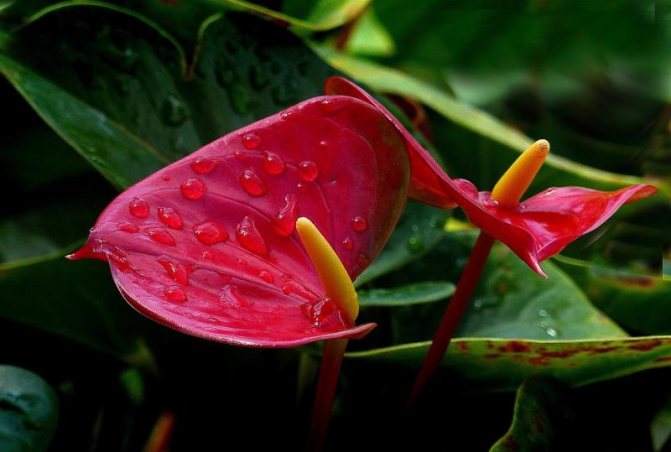

Exotic anthurium, or as it is called "male happiness", pleases with beautiful foliage, unusually bright flowers with delicate inflorescences that look like a candle. If you want the plant to feel comfortable at home, you should know the secrets of care and transplantation.
Why do you need rejuvenation?
The older the anthurium becomes, the less beautiful it becomes. The lower leaves gradually die off, exposing the unattractive trunk of the plant. Leaves and flowers get smaller, often growing with curled tips. Sometimes the flowering of anthurium stops altogether.
If the flower has lost its decorative appearance and began to wither, then in order to revive it to a new life and again admire the gorgeous flowers of "male happiness", it is necessary to carry out a rejuvenation procedure.
Bloom
Flowering period, flower shape
Anthuriums are among the longest flowering plants. The flowering break can be only a few months of winter time.
The flower is very remarkable in shape: the flower inflorescence in the form of a cob is surrounded by a veil that can twist in the form of a spiral or simply be located next to it at an angle to it.
The red color of the coverlet is the classic color for anthurium. But lately, breeders have brought out many other colors and shades. Delicately greenish, yellow, orange, brown. The pink color of the bedspread is popular. Sometimes they even confuse white anthurium with spathiphyllum.
Plant care after flowering
After the plant shows signs of wilting of the flower, it is necessary to cut the flower and transfer the flower to winter mode. That is, reduce the temperature, water less often and limit feeding.
This will set the stage for the next flowering seasons. Lighting in winter should not be dimmed.
Correct transplantation of anthurium "male happiness": an introduction
Young specimens up to 4 years old must be replanted every year, since they are actively growing and need to expand the space. They need to be handled with a lump of earth so that the young roots are not damaged, and the flower is easier to adapt.
Adult plants are transplanted every 2-4 years and often combine this with replanting an old bush (reproduction by dividing the bush and "children").
Transplant reasons
- The pot is cramped, the roots are visible in the drainage holes, or the aerial roots are badly exposed.
- Anthurium is sick and an examination of the roots is required, as there are suspicions that they have rotted.
- Incorrect soil composition (transshipment with a clod of earth).
- You need to plant an old flower.
- Repotting a healthy plant regularly to renew the potting mix.
- Buying a flower.
When is it better to transplant "male happiness"?
Favorable time for transplanting anthurium at home: mid-February - March. During this period, he is in a state of relative rest and it is easier to tolerate manipulations with the roots.
If necessary, the flower can be transplanted from March to August, taking precautions.
Can Anthurium be transplanted during flowering?
If "male happiness" blooms, then it can be transplanted, since the aroids have persistent flowers, unlike many flowering species. If you bought a flowering plant (99%), then you need it, especially in a tight container and protruding roots from the drainage holes - more about this, below in the article.
How to transplant blooming anthurium correctly?
The transplant of blooming "male happiness" should be carried out especially carefully so as not to damage the roots and only by the transshipment method. According to the general step-by-step instructions.
How to transplant an old anthurium at home?
If you do not want to plant an old flower, then the transplanting process is the same, but if you want to divide it into several parts and multiply, then read about this in the article on reproduction at home - at the bottom of the page link.
Can the roots be trimmed?
There is no need to trim healthy roots, and if they are rotten (brown, soft and literally "creeping" in the hands), then you need to trim them to a healthy area, followed by dusting with activated carbon powder and treating with fungicides.
Anthurium transplant after buying at home: is it possible or necessary?
We are often asked: "Is it necessary to transplant" male happiness "after the purchase?" We believe that every purchased anthurium has a need for a transplant, and the differences are only in terms of time.
If this is not done (only transshipment for healthy specimens!), Then the leaves will begin to fade and then turn black, and the flowers will dry out.
When should you transplant?
If you bought a healthy flower with roots that do not cause suspicion of rot and are not visible in the drainage holes, then it is better to transplant it 3-7 days after bringing it home.
Specificity of a tropical plant
Anthurium should be purchased from a garden nursery that specializes in tropical plants. For the best selection, you need to look for a retailer that offers several different types of culture.
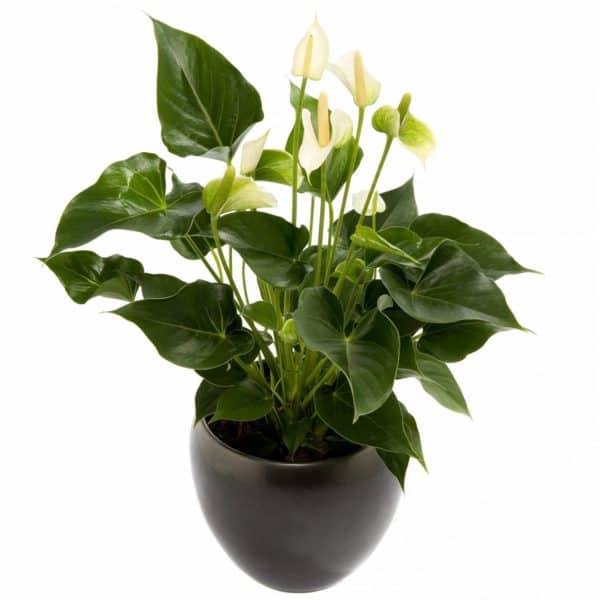

Spectacular anthurium White Heart, grown in a garden nursery.
It is imperative to pay attention to the conditions in the garden center. The flower does not tolerate excessive heat or cold. Extreme heat can damage the leaves and shorten the flower's life cycle. Extreme cold causes the foliage to turn yellow and stops the plant from growing.
A package of Andre's anthurium seeds (a subspecies is often called “male happiness”) can be purchased for 98 rubles. In a package, on average, 20 seeds. An adult plant of the "Andrianum Baby Boomer" variety in a container is sold at a cost of 780 rubles.
What kind of pot is needed for anthurium? Size, photo and material
It is better to select a wider than a deep container, but not too much so that the water does not stagnate. "Male happiness" loves tight and low pots.
Therefore, if you want the plant to bloom profusely, then plant it in a little "cramped" one, and to stimulate the appearance of "children" buy a wider container. A new pot for transplanting a young flower, choose 1-2 cm larger in diameter than the old one, and for adult plants 2-3 cm wider.
Pot size
1-2 years old: 11-14 cm in diameter, 3-4 years old: 15-17 cm, 5-6 years old: 18-20 cm in diameter, and height 12-13 cm.
The flower can be sold in containers with a diameter of nine to 17 cm, but most often 12 cm (height 35-45 cm), 14 cm (plant height - 40-55 cm) or 17 cm (height - 60-75 cm). When replanting after purchase, a new pot is usually 14-19 cm in diameter and 12-16 cm in height.
We have indicated the approximate dimensions of the container, since depending on the variety and growing conditions, plants of the same age may differ in the level of development.
What land to transplant "male happiness"? Compositions and types of soil
Anthurium needs a loose and well-drained slightly acidic (pH-5.5-6.5) soil with a sufficient amount of nutrients, into which air penetrates well.
In nature, the flower grows initially on a tree or eventually passes on to it (epiphyte - Andre, Scherzer and Khrustalny). Therefore, it can absorb substances from the forest floor, and the roots need free access to air.
Potting mix components
To prepare at home the land for transplanting, it is necessary to use the various components in the correct ratio.
- The basis of the soil for "male happiness" can be ordinary high-moor peat (low-lying peat - not!). If it is not on sale, then you can take any universal soil with a slightly acidic reaction, for example, for flowering species.
- To increase looseness and lightness, the base must be supplemented with the following components: chopped pine bark or chips, sphagnum, charcoal (saves roots from decay) and a little coconut fiber.
- To prevent stagnant water that leads to root rot, use vermiculite or perlite, and if not, then coarse sifted and calcined sand.
Post-transplant care
They take care of the anthurium after transplantation as usual, but much depends on its condition and age.
How to water?
The frequency of watering a flower depends on the moisture content of the soil, which is influenced by the temperature and humidity of the air, as well as the composition of the earth.
Water the "male happiness" after transplanting after the top layer of the potting mix dries 2-3 cm in spring and summer and a third in autumn and winter.
Do not forget to spray and wipe the leaves, as well as ventilate the room.
Top dressing
The first 30-50 days, depending on the composition of the soil mixture, you do not need to feed the flower after transplanting. After this period, start gradually applying fertilizers (in spring and summer), as described in the article on caring for "male happiness" at home.
Why do the leaves of anthurium turn yellow after transplantation?
The leaves of a flower can turn yellow for many reasons, in order to better understand the essence of the problem, you need to know its condition before transplanting and care after transplanting. If you transplanted "male happiness" with yellow leaves, what was the condition of the roots? Was it rotten?
If the roots were healthy, and the specimen was strong and the leaves began to turn yellow after transplanting, then analyze your watering, air humidity (spraying, rubbing the leaves) and lighting (did the plant shade or not?).
Division of anthurium during transplantation
Transplanting anthurium can be combined with its reproduction in a vegetative way - dividing the bush. The first time to divide an anthurium bush can only be in the fourth year of its growth, and the best moment for this is when the plant sheds all its leaves (in January or February). Dividing the anthurium during transplanting does not require any special skills from you: remove the bush from the pot, carefully divide it so that leaves and buds are evenly located on each part.


If it is impossible to separate the tangled, accreted roots with your hands, cut them with a sterile sharp instrument and plant the bushes as quickly as possible in small pots with a good drainage layer in the manner described by us. Water them.
Landing
Before landing on the bottom of the container, be sure to lay drainage (expanded clay, small pebbles, brick breakage with pieces of charcoal), a layer of which takes up to a third of the volume of the pot.
Coarse sand can be poured over the drainage layer, and then the root system can be placed - it is better together with an earthen lump.
Special attention should be paid to the condition easily breaking roots and carefully remove damaged and tainted areas by sprinkling the injured area with crushed charcoal.
You can also treat them with a root stimulant.
Then add the prepared soil mixture, trying deepen the young superficial roots a little, and carefully compact it. Aerial rootsremaining on the surface should be covered with sphagnum and moistened regularly.
Most often, when landing, you need to take care of plant support.
Watering methods for aturium
For watering anthurium, it is better to use settled water at room temperature. The plant is mainly watered from above into the pot, but you can also do this through the pallet. When watering overhead, water should be poured until it appears in the sump. Then let the flower stand for 30 minutes and drain off all the liquid that is glass. With constant watering of anthurium through the pallet, it is necessary from time to time to use a surface method so that the earth is completely saturated with moisture.If the tips of the leaves begin to dry out, brown spots appear on them, and the flowers fade quickly, it means that the anthurium does not have enough moisture.
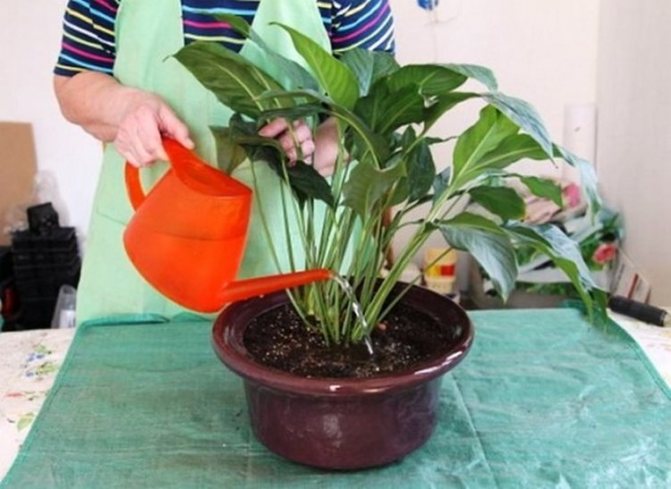

Florists' headache: "care" problems and how to solve them
Cultivating "male happiness" at home is not easy due to its capricious nature. Instead of admiring the beauty of the plant, you often have to think about how to save the "pet". Why do the leaves of anthurium turn black, the plant begins to turn yellow and dry out? Most flamingo flower diseases are caused by improper care. You can save the plant if you make work on the mistakes. And here it is important to determine the cause of the problem, which will help the following table.
Table - Problems when growing anthurium and their causes
| Problem | The reasons |
| Leaves turn yellow | - Long-term waterlogging of the earthen coma; - chlorinated water; - too concentrated makeup; - insufficient lighting; - tight capacity |
| Leaves turn black | - Drafts; - too dry air; - violation of the temperature regime (too hot or cold); - direct rays of the sun; - substrate with excess potassium |
| Brown spots | - Waterlogging; - unsuitable soil; - damage to the root system; - hypothermia of the roots; - hard or too cold water |
| The tips of the leaves dry | - Anthracnose (weakened plants, flowers with mechanical damage are ill) |
| The plant dries up | - Insufficient watering; - dry air |
| Leaves curl | - Drafts; - dry air; - lack of light |
| Withering foliage | - Root decay from overflow |
In order for the "flamingo flower" to delight with its beauty for a long time, you need to study all the subtleties of care. If comfortable conditions are created for the tropical guest, the leaves will have to be cut only from "old age", and not because they have lost their attractiveness.
Many problems can be solved by optimizing care. But if there is rotting of the roots, then you need to immediately transplant the plant. The longer you postpone the transplant, the less chance you have of saving the flower. When transplanting, you need to cut off the affected root parts, and hold the remaining parts in the air for half an hour to dry. If you plan to simply replace the soil, leaving the same container, be sure to disinfect it with a strong manganese solution.
Popular varieties of anthurium
Hybrids are the most popular among home garden lovers. The most common is Andre anthurium. The reason is that the plant blooms almost all year round. Sheets - "sails" can be white, pink, red, burgundy. Scarlet Andre Dakota is different here.
Scherzer's anthurium is also widely known. Its "sails" are more rounded, their colors are white, orange, red, with bizarre specks. It also blooms profusely and often.
Among the leafy species, the multi-dissected anthurium is widespread. Outwardly, it resembles a liana with "fingers" leaves. Crystal anthurium is also popular, characterized by heart-shaped leaves with white veins, resembling crystal in their pattern.


